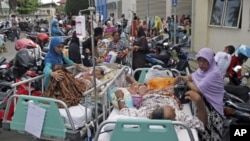Experts say the earthquake and tsunami scare off the coast of Sumatra, Indonesia, was a successful test of disaster preparedness in the region.
Tsunami warning sirens on Thai beaches blared and people quickly headed to high ground shortly after Wednesday’s 8.6 magnitude quake struck the Indian Ocean about 430-kilometers southwest of Banda Aceh.
Evacuation orders were also issued in Indonesia, India, Sri Lanka, and Burma through TV, radio, and mobile phone text messaging.
In the end, the quake did not create a dangerous tsunami, there was little damage, and few casualties.
“From our perspective the fact that the warning went out five minutes, no more than five minutes after the earthquake erupted, went out in Indonesia and was followed shortly after that by other warnings within the system at 8:45, 8:46, 8:48, I think went extremely well," said Wendy Watson Wright, a spokeswoman for the U.N. cultural agency’s Intergovernmental Oceanographic Commission based in Paris. "I also believe that, in Indonesia at least, that the population showed that they have learned and that self-evacuation was taking place in Aceh."
The Intergovernmental Oceanographic Commission developed the Indian Ocean Tsunami Warning System after a 9.1 magnitude earthquake in 2004 caused massive waves that killed 230,000 people, mainly in Indonesia. Aceh was the worst affected.
Laurence Dare with the Asian Network for Free Elections was in Aceh to monitor local polls when Wednesday’s quake occurred. Coincidentally, he had just finished a visit to the 2004 tsunami museum when the ground started to shake.
“People did not know what it was at first, but after, you know, 15 seconds everybody started to rush away from the building. The building itself was swaying and there was a big pane of windows that was moving quite a bit. And, I think a lot of people were worried that they might break and come down," said Dare. "So, everybody went out toward the road and not long after that it seemed like everybody jumped in their cars, on their motorbikes, and just started heading in one direction. Which, I learned, was in the direction away from the ocean.”
Dare said although there was some panicking and crying, people knew to get away from the beach and did so in an orderly fashion, obeying traffic rules.
Aceh and the rest of the region were spared from major damage largely because the quake, while at about the same depth below the ocean as the one in 2004, moved horizontally rather than vertically, creating much smaller waves.
"They took the early initiative and issued the warning, and people heeded it. So in many ways it was very encouraging, but obviously we would also like to say that there is still much work that needs to be done. There is still a lot of end-to-end disaster preparedness that needs to take place. It is a good sign, and in some ways I think it was a lucky escape," said Esther Lake, a spokeswoman for the Bangkok-based Asian Disaster Preparedness Center.
Lake says that governments have built up impressive infrastructure and improved public knowledge since the 2004 tsunami, Wednesday’s quake was a good opportunity to assess disaster preparedness at local levels.
Gabrielle Paluch contributed to this story.
News
Indian Ocean Quake, Tsunami Scare Tests Preparedness







